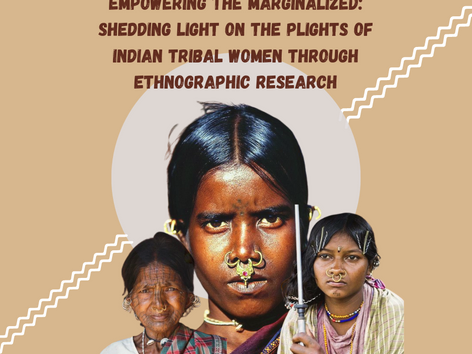Learning Outcomes:
- To understand the role of Ethnographic Research in uncovering the plight of marginalised sections
- To illustratively understand the hardships faced by the tribal women in India
- To gain an insight into the key challenges faced by Indian tribal women and learn how to solve them by employing ethnographic research

In terms of healthcare, Indian tribal women face numerous challenges, including limited access to healthcare facilities, inadequate maternal and child healthcare services, and high rates of maternal mortality. The cultural and linguistic diversity of tribal communities further exacerbates these challenges, as it often leads to a lack of culturally sensitive healthcare services.
Economic empowerment is another major challenge for Indian tribal women. Many tribal communities rely on subsistence agriculture or traditional occupations, which offer limited income-generating opportunities. Lack of access to credit, markets, and resources further restricts their economic prospects. This economic marginalization not only perpetuates poverty but also limits their ability to assert their rights and make decisions that affect their lives.
Understanding Ethnographic Research

- Participant observation: Researchers live among tribal communities, participating in their daily activities and observing their social interactions. This method allows researchers to gain an in-depth understanding of the cultural practices, social structures, and power dynamics within the community.
- In-depth interviews: Researchers conduct open-ended interviews with tribal women to explore their experiences, perspectives, and aspirations. These interviews provide valuable insights into the challenges they face and the strategies they employ to navigate their daily lives.
- Focus groups: Researchers facilitate group discussions among tribal women to explore shared experiences, social norms, and collective aspirations. Focus groups provide a platform for women to voice their concerns, share their stories, and collectively identify strategies for empowerment.
- Document analysis: Researchers analyze documents such as government policies, community records, and historical archives to understand the broader socio-political context within which tribal women live. This analysis helps to uncover systemic issues and identify areas for intervention and advocacy.
Important Case Studies



Findings and Insights from the Ethnographic Research

By filling the gaps in knowledge and understanding, we can develop evidence-based policies and interventions that effectively address their needs. There is a need for collaboration and partnership between government agencies, civil society organizations, and tribal communities themselves. By working together, we can leverage our collective strengths and resources to bring about meaningful change.
References
Mehta, Sunil K., and Moyna Chakravarty. n.d. “Nutritional Status of Baiga women of Chhattisgarh, India: An Anthropological Insight.” IOSR Journal of Environmental Science, Toxicology and Food Technology (IOSR-JESTFT) https://www.iosrjournals.org/iosr-jestft/papers/Vol14-Issue7/Series-1/A1407010103.pdf
Pradhan, Ashok, and AMIT SONI. 2015. “CULTURAL CHANGE AMONG THE BAIGA TRIBE OF MADHYA PRADESH AND CHHATTISGARH.” Humankind 11. https://serialsjournals.com/abstract/47432_11.pdf
Premi, Jitendra K. n.d. “RJPT – Incidence of Infant Death among the Baiga Tribe of Chhattisgarh, India.” Research Journal of Pharmacy and Technology. Accessed June 26, 2023. https://rjptonline.org/HTMLPaper.aspx?Journal=Research%20Journal%20of%20Pharmacy%20and%20Technology;PID=2021-14-6-36





